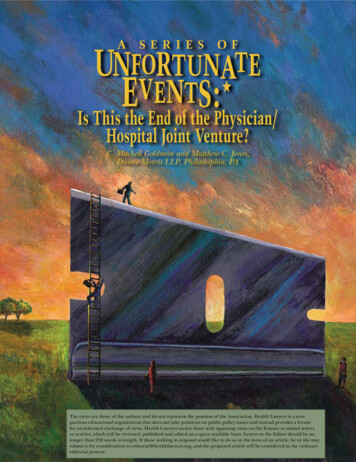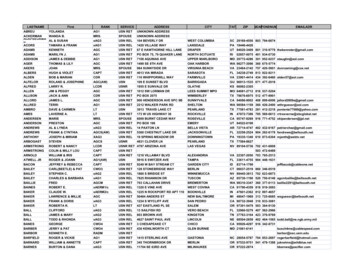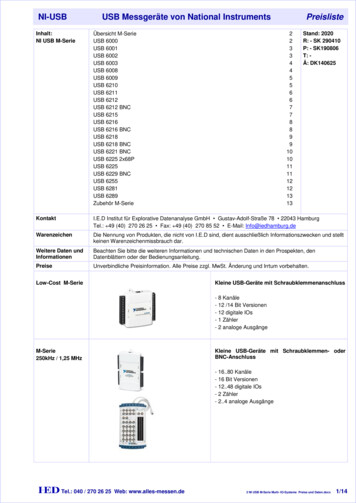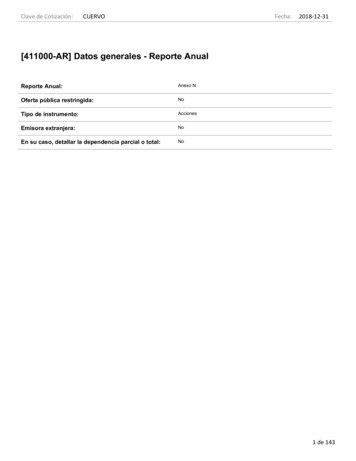
Transcription
ASe r i e sofUnfortunatevents:*EIs This the End of the Physician/Hospital Joint Venture?C. Mitchell Goldman and Matthew C. Jones,Duane Morris LLP, Philadelphia, PA8The views are those of the authors and do not represent the position of the Association. Health Lawyers is a nonpartisan educational organization that does not take positions on public policy issues and instead provides a forumfor an informed exchange of views. Health Lawyers invites those with opposing views on the Feature to submit lettersor articles, which will be reviewed, published and edited on a space available basis. Letters to the Editor should be nolonger than 250 words in length. If those seeking to respond would like to do so in the form of an article, he or she maysubmitit for considerationHEALTHLAWYERSNEWSto editorial@healthlawyers.org, and the proposed article will be considered in the ordinaryeditorial process.
I.IntroductionDuring the last several years, physician joint ventures of all kinds havecome under increasing regulatoryscrutiny, and the legitimate business purposes of physician/hospitaljoint ventures such as imagingcenters, ambulatory surgicalcenters, cardiac catheterizationlaboratories, and hospitals havebeen challenged. The nationalcredit crisis and the downturn inthe overall economy also have put adamper on the willingness of hospitals and physicians to jointly investand share the risks and rewardsof new healthcare facilities andservices. This article summarizessome of the regulatory pressuresand the impact that they, and thecollapse of the credit markets,are having on existing and futurejoint ventures. Although the futureviability of the physician/hospitaljoint venture is by no meanscertain, there may still be opportunities for doctors and hospitals tocollaborate.II. Federal Regulation of PhysicianJoint VenturesFor the past twenty years, federalregulation of joint venturesinvolving physicians has fluctuated between uneasy tolerance andopen hostility. In 1989, the Officeof Inspector General (OIG) of theDepartment of Health and HumanServices marked the beginning ofthis period by issuing a “SpecialFraud Alert” (which was reprintedin the Federal Register in 1994) on“Joint Venture Arrangements.”1 Inthis Alert, the OIG described thearrangements that were causing itconcern as follows:The Office of Inspector Generalhas become aware of a proliferation of arrangements betweenthose in a position to referbusiness, such as physicians, andthose providing items or servicesfor which Medicare or Medicaidpays . . . . Sometimes these dealsare called “ joint ventures.’’ Ajoint venture may take a varietyof forms: it may be a contractual arrangement between twoor more parties to cooperatein providing services, or it mayinvolve the creation of a newlegal entity by the parties . . . toprovide such services.2The OIG’s stated reason for questioning the validity of physicianjoint ventures was that “some ofthese joint ventures may violate theMedicare and Medicaid anti-kickback statute”: 3These subject joint ventures maybe intended not so much to raiseinvestment capital legitimatelyto start a business, but to lockup a stream of referrals fromthe physician investors and tocompensate them indirectly forthese referrals. Because physicianinvestors can benefit financiallyfrom their referrals, unnecessary procedures and tests may beordered or performed, resultingin unnecessary program expenditures.4Nevertheless, the OIG did recognize that physician joint venturescould be formed in order tofurther genuine and lawful goals:“Of course, there may be legitimatereasons to form a joint venture,such as raising necessary investment capital.”5This pattern of alternatingconsternation and acquiescenceover allowing physicians to benefitfrom their referrals through a jointventure entity has been evidencedin a line of OIG Advisory Opinions,6a Special Advisory Bulletin thatwas issued in 2003,7 and a series ofregulations issued pursuant to thefederal Stark Law, 8 in which regulators have struggled to prevent theimproper use of physician jointventures while allowing legitimatejoint ventures to exist.Although thefuture viabilityof the physician/hospital jointventure is by nomeans certain,there may stillbe opportunitiesfor doctors andhospitals tocollaborate.III. Impact of Recent RegulatoryChanges on Physician JointVenturesRecently, the regulatory pendulumhas swung to the “prohibition”end of its arc. A major revision tothe Stark Law regulations that wasimplemented by the Centers forMedicare and Medicaid Services(CMS) as part of the final 2009Hospital Inpatient ProspectivePayment System will soon effectively prohibit “under arrangement”joint ventures between hospitalsand physicians. Over the past fewyears, the “under arrangement”structure has become increasinglypopular as a means for hospitalsand physicians to co-invest in, andrefer patients to, healthcare businesses such as cardiac catheterization labs and diagnostic imagingcenters. The structure relies onprovisions in the Stark Law regulations that define a “hospital” as notincluding “entities that performservices for hospital patients ‘underarrangements’ with the hospital,”9and that carve out from the definition of “ownership and investmentinterests” any “under arrangementsFEBRUARY 20099
contract between a hospital and anentity owned by one or more physicians (or a group of physicians)providing [designated healthservices] ‘under arrangements’with the hospital . . . .”10 Thesedefinitions have allowed physicians to invest in joint venturesthat provide “designated healthservices” (DHS) to hospital patients“under arrangement” and to referpatients to such joint ventures,without having to meet one of theStark Law exceptions for ownership interests. Effective October 1,2009, CMS revised the Stark Law’sdefinition of “entity” to “clarify thata person or entity is consideredto be ‘furnishing’ DHS if it is theperson or entity that has performedthe DHS (notwithstanding thatanother person or entity actuallybilled the services as DHS) orpresented a claim for Medicarebenefits for the DHS.”11 Under thisnew definition, an “under arrangement” joint venture entity will beconsidered to be “furnishing” DHS,since it is actually performing theDHS. Physician investors in thejoint venture therefore will needto qualify for an exception to theStark Law’s prohibition on referrals in order to refer patients tothe joint venture. In most cases thiswill be very difficult to accomplish,necessitating either the completedissolution of the joint venture or arestructure of the joint venture intoa legally compliant, but less profitable, form.Other recent regulatorychanges that have not been aimeddirectly at physician joint ventureshave been, when consideredtogether, almost as restrictive. Forexample, in issuing its 2008 Medicare Physician Fee Schedule, CMSextended the rule known as the“anti-markup rule” to cover notonly the technical component ofpurchased diagnostic tests, but theprofessional component as well.12Prior to the change, the antimarkup rule prevented providers10HEALTH LAWYERS NEWSof diagnostic imaging servicesfrom purchasing the technicalcomponent of a diagnostic imagingservice from a third party supplierand “marking up” the cost of theservice when billing Medicarefor the service, thereby profitingfrom the “markup.” Explainingthat “studies have shown that,in the aggregate, utilization ofdiagnostic tests increases in theFinancing jointventures, for theforeseeable future,will require a muchhigher proportionof equity at a timewhen both hospitalsand physiciansdo not have thecapital to invest.case of physician self-referral,”13CMS announced that it was “alsoimposing an anti-markup provision on [the professional component] of diagnostic tests that areordered by the billing physician. . . if the [professional component] is outright purchased or . . is not performed in the officeof the billing physician . . . .” 14 Byextending the anti-markup rule toprofessional services, this changeadds a new wrinkle to the structuring of diagnostic testing jointventures by precluding them fromprofiting from the professionalcomponent of the diagnostic teststhat they perform, where the physician or group that provides theprofessional component is doing soon an independent contractor basisand assigning to the joint ventureits right to receive payment fromMedicare.In addition to virtuallybanning “under arrangement” jointventures, CMS’ final 2009 HospitalInpatient Prospective PaymentSystem rulemaking revised theStark Law regulations to imposenew limits on the use of percentage-based compensation formulaeand “per click” payments in leasearrangements that will make itmore difficult to structure jointventures that are both legal andfinancially worthwhile.15Even proposed new regulationsthat are never finalized may havea chilling effect on physician jointventures. In 2007, the U.S. Houseof Representatives approved legislation16 that, if made law, would havesignificantly altered an exception tothe Stark Law known as the “wholehospital exception.” The “wholehospital exception” permits a physician to refer patients to a hospitalin which the physician holds anownership interest as long as thephysician owns an interest in the“entire hospital and not merely in adistinct part or department of thehospital.”17 The changes would haveprecluded new physician investments in hospitals, thereby puttingan end to a trend of increasedphysician investment in bothgeneral and specialty hospitals.Existing physician-owned hospitalswould have been “grandfathered”under the new legislation, butwould have been severely restrictedin their ability to expand due to aban on any increase in the numberof their licensed beds.18 Althoughthe legislation was ultimately notenacted, these restrictions and thecontinued governmental focus onreducing or eliminating physicianownership of hospitals have likelymade many entrepreneurial physicians extremely cautious about anyplans to invest in new hospital jointventures.
IV. The Credit Crisis—The LastShoe to Drop on Joint VenturesWhile the regulatory environmenthas made hospital/physician jointventures financially challenging,the dramatic downturn in theeconomy and the subsequent tightening of commercial and consumercredit also has had a significantimpact. As has been well documented in the national press, thecollapse of the housing market dueto the growth of subprime mortgages and the packaging of thistype of credit by Wall Street hashad far-reaching and unintendedconsequences well beyond thebanking and real estate markets.Hospitals and physicians did notescape the negative impact of thenational credit crisis.During down markets hospitals typically have problems withliquidity, but the current situationis truly a “perfect storm.” Mostrecessions bring high unemployment and increasing numbersof patients without insurance,resulting in an increase in baddebt. In addition, as hospitalinvestment income is reduced,hospitals struggle to achieveprofitability. However, this creditcrisis has brought other surprisesthat have made access to casheven more difficult. For example,many nonprofit hospitals weresurprised to learn that they ownedauction rate securities that werenot liquid and carried seriousinterest penalties. Auction ratesecurities were sold to hospitals asa cash alternative that could earna low interest rate and could beeasily converted to cash providedthat the securities could be pricedand sold at regularly scheduledauctions. Few, if any, hospital chieffinancial officers and investmentadvisors contemplated that theauction market would not exist,making cash investments illiquidand triggering certain interest ratepenalties under these securities. Toaddress this crisis of liquidity, manyhospitals have found themselvesrefinancing, if possible, under verydifficult terms or accepting significantly higher interest payments.Compounding this difficultcash position is the continuingdecline in the value of hospitalendowments. As hospital balancesheets weaken, some facilitieshave had difficulty meeting theircoverage ratios required undertheir tax-exempt bond financings. A number of financial ratingagencies have described a negativeoutlook for the future for nonprofithospitals.19 Under these conditions,many hospitals will not be in afinancial position to invest in newjoint venture opportunities.Similar to hospitals, physiciansalso are finding themselves in aweaker financial position as theirpractice income and the value oftheir investments decline. Manyphysicians historically have reliedon joint venture transactions thathave required small equity investments and a significant assumptionof debt. Leveraged transactionshave all but become extinct dueto the difficulty in pricing debtand the resulting credit squeeze.Financing joint ventures, for theforeseeable future, will require amuch higher proportion of equityat a time when both hospitals andphysicians do not have the capitalto invest.V. Credit Issues: Making Regulatory Compliance DifficultWhile new joint ventures may be“on hold,” existing joint ventureswill have their own problemscomplying with CMS regulationsdue to the credit market turmoil.Those ventures that have todissolve their current businessesmay find that their banks may notbe very cooperative, especially ifthere is outstanding debt that mustbe repaid. Those ventures that will“morph” into another type of entityalso may face the same difficultieswith lenders. If the new venturestructure requires a recapitalizaHospitals and Health SystemsPractice Group LeadershipBrian D. Gradle, ChairVice President, CorporateResponsibilityBon Secours Richmond HealthSystemRichmond, VAbrian gradle@bshsi.orgMarc D. Goldstone, Vice Chair –Educational ProgramsVice President and AssociateGeneral CounselCommunity Health Systems Inc.Franklin, TNmarc Goldstone@chs.netMichael C. Hemsley, Vice Chair –ResearchGeneral Counsel & Vice PresidentLegal ServicesCatholic Health EastNewtown Square, PAmhemsley@che.orgMarci Rose Levine, Vice Chair –PublicationsSonnenschein Nath & Rosenthal LLPWashington, DCmlevine@sonnenschein.comHal McCard, Vice Chair –MembershipVP & Associate General Counsel,Division IVCommunity Health Systems Inc.Franklin, TNhal mccard@chs.netClaire M. Turcotte, Vice Chair –Strategic ActivitiesBricker & Eckler LLPWest Chester, OHcturcotte@bricker.comThanks go to the Practice Group forsponsoring this feature.FEBRUARY 200911
tion, the parties may be unable tocomplete the transaction. For thoseentities that are unable to unwindwithout a financial disaster, thereare other strategies to consider.flexible the bank can be in helpingto fund the new venture. Whilepainful to hospitals and physicians,restructuring debt is becoming aA. Sales to Third Parties:Roll-Ups Are Back!Financially struggling healthcareventures have several choices toconsider if they cannot unwind.First, they could sell their jointventure to a third party. For someimaging centers and ambulatorycenters, there are a number offor-profit companies seeking topurchase healthcare assets as partof an existing “roll-up” strategy. Inaddition, some private equity fundsinvest exclusively in distressedassets and have targeted healthcareas a potential investment opportunity. These acquisition strategiesmay seem contrary to the decline inthe overall economy, but operatingcompanies and private equity fundswith cash thrive in down markets.During the next several quarters,these entities will be looking forbuying opportunities. Hospitalsystems and their physician jointventurers could benefit from thesale of struggling joint venturesto operating companies by takingback cash or stock in the transaction. While valuations have plummeted in some cases, there are stillbuyers willing to pay a reasonablevaluation for an enterprise withsome cash flow.While new jointventures may be“on hold,” existingjoint ventureswill have theirown problemscomplying withCMS regulationsdue to the creditmarket turmoil.B. Restructuring Debt . . .If You CanSecond, some ventures have considered negotiating with lenders torestructure their relationship asthe venture unwinds. Smaller localbanks have often been supportiveof these new ventures and havebeen willing to find innovative waysto restructure existing debt. Theimportance of the hospital and/orthe physicians as customers of thebank and the financial conditionof the bank will determine how12HEALTH LAWYERS NEWScommon occurrence and a goodway to breathe new life into anorganization with limited options.C. Business Reorganization: ItMay Be the Only OptionFinally, some joint ventures willhave to consider a reorganizationstrategy that involves a bankruptcyfiling. There have been a numberof imaging centers and ambulatorysurgery centers that have had toconsider these distressed strategiesdue to declining reimbursementand increased competition. Thereis also a belief among investment analysts that there will be acontinuing increase in the numberof hospital bankruptcies due totheir declining financial condition.VI. New Opportunities for Hospitals and PhysiciansMost of the current joint venturesbetween hospitals and physicianswere entered into for severalreasons: Hospitals were looking forways to strengthen the relationshipbetween a group of doctors and thehospital, and to reduce competitionfor patients for a specific service.Doctors also were attempting toreduce competition, as well as toshare the cost and the risk of a newenterprise. Of course, all of theinvestors also were motivated by thepotential to earn a profit. However,few joint ventures contemplated anexit strategy to maximize the enterprise value of the joint venture, orthe proverbial investment banking“liquidity event.” In a “down”market, what types of collaborative transactions can physiciansand hospitals undertake given thecurrent regulatory environment?A. Co-Investment Opportunitieswith Hospital Private EquityFundsSome new opportunities are beingundertaken that may provide someinsights into future joint venturerelationships. One of the key areasfor hospital and physician collaboration could be healthcare-relatedinvestments. Some large hospitalsystems have developed their ownprivate equity funds that invest instart-up healthcare companies aswell as companies that are seekingcapital investment to supportgrowth. These hospital privateequity funds could be open tophysician investment as anotherway to more closely align the physicians’ and the hospitals’ interests.While risk-averse hospitals andphysicians would argue against sucha strategy given the economic conditions, for some entrepreneurialhospitals and doctors such investments could provide real opportunities to share risk and reward.B. Leveraging Hospital andPhysician Resources withStart-Up BusinessesMost hospitals and physicians willnot have the capital to invest ina fund or create their own fund.Hospitals have used their resources
and have made in-kind contributions to start up ventures. Forexample, in exchange for stock ina new company, a hospital and keyphysicians may offer their technicalexpertise to the start-up. Suchtechnical expertise may includeusing the hospital as a “beta site”for use of a new device, software,or product. Physician input alsois valuable especially for medicaldevices and some software applications. The overall strategy in theseapproaches is to find a way forhospitals to collaborate with physicians and to leverage the resourcesthat they can offer to a start-upcompany in exchange for stock,thereby eliminating the need forthem to make a cash investment.C. Private Equity PartnershipsNeither hospitals nor physicianshave traditionally collaborated withprivate equity investors on a formalbasis. In fact, many private equityfunds have significant informalrelationships with hospitals andphysicians to “pick their brains”about certain investments thefund is considering. Private equityfirms are looking at the healthcare industry as one of the growthareas in the economy. Instead ofcontinuing an informal process,hospitals and physicians shouldconsider formalizing the relationships with private equity fundsin the same manner as describedabove with respect to start-upbusinesses.VII. Some Final ThoughtsThe future for hospital/physician joint ventures is uncertain atbest. It would not be surprising ifmost hospitals and physicians “siton the sidelines” until there areclear signals that the financial andregulatory environment for jointventures is more secure. However,there are always those who will findopportunity amidst the currentconfusion. Hospitals and physicians will need to find new ways tocreate long-term enterprise value,not short-term cash value, by usingtheir collective resources as thecurrency to obtain ownership innew ventures.Hospitals andphysicians will needto find new ways tocreate long-termenterprise value,not short-term cashvalue, by usingtheir collectiveresources as thecurrency to obtainownership innew ventures.C. Mitchell Goldman is a partner inthe Healthcare Practice Group of DuaneMorris LLP in Philadelphia, PA. Mr.Goldman concentrates his practice onadvising hospitals and physicians onthe healthcare regulatory and corporateissues associated with joint ventures andmergers and acquisitions. He also workswith physician entrepreneurs developingnew businesses and has recently starteda new organization, Physician Entrepreneurs’ Roundtable, a physician/privateequity networking group.Matthew C. Jones is a partner in theHealth Law Practice Group of DuaneMorris LLP. His practice is focused oncounseling hospitals, health systems,physicians, practice groups, and otherservice providers on various aspects ofhealthcare transactions, such as mergersand acquisitions, service contracts, theformation of joint ventures, licensureand regulatory issues, and tax issuesaffecting both nonprofit and for-profitentities. He is also based in Philadelphia.* Apologies to Lemony Snicket.1 59 Fed. Reg. 65372 (1994).2 Id. at 65373.3 Id. The federal anti-kickback statuteprohibits the offering, payment,solicitation or receipt of remuneration (including any kickback, bribe orrebate), directly or indirectly, overtly orcovertly, in cash or in kind, for (i) thereferral of patients or arranging for thereferral of patients to receive servicesfor which payment may be made inwhole or in part under a federal orstate healthcare program, or (ii) thepurchase, lease, order, or arrangingfor the purchase, lease or order ofany good, facility, service, or item forwhich payment may be made under afederal healthcare program. 42 U.S.C. §1320a-7b.4 59 Fed. Reg. at 65374.5 Id. at 65373.6 See, e.g., OIG Advisory Opinion 98-12(Sept. 16, 1998) (ambulatory surgerycenter joint venture among orthopedicsurgeons and anesthesiologists); OIGAdvisory Opinion 04-17 (Dec. 10,2004) (pathology services joint venturebetween pathology laboratory companyand physician group practices); OIGAdvisory Opinion 08-10 (Aug. 19, 2008)(block lease arrangements betweenoncology group practice and urologists).7 68 Fed. Reg. 23148 (2003).8 See 66 Fed. Reg. 856 (2001); 69 Fed.Reg. 16054 (2004); 72 Fed. Reg. 51012,(2007). The Stark Law prohibits physicians who have a “financial relationship” with an entity from referringMedicare or Medicaid patients to thatentity for one or more “designatedhealth services” unless one of severallimited exceptions applies. Under theStark Law, a “financial relationship”exists if the physician or an immediatefamily member has a direct or indirectownership or investment interest in,or compensation arrangement with,the entity providing designated healthservices. 42 U.S.C. § 1395nn.9 42 C.F.R. § 411.351.10 42 C.F.R. § 411.354(b)(3)(iv).11 73 Fed. Reg. 48713 (2008).12 72 Fed. Reg. 66306 (2007).13 Id. at 66313.14 Id. at 66308.15 73 Fed. Reg. at 48713.16 H.R. 3162, § 651.17 42 C.F.R. § 411.356(c)(3)(iii).18 H.R. 3162, § 651.19 For example, on December 2, 2008,Fitch Ratings issued a press releasestating that it had “revised its Outlookon the U.S. not-for-profit hospital sectorto Negative from Stable.”FEBRUARY 200913
was issued in 2003,7 and a series of regulations issued pursuant to the federal Stark Law,8 in which regula-tors have struggled to prevent the improper use of physician joint ventures while allowing legitimate joint ventures to exist. III. Impact of Recent Regulatory Changes on Physician Joint Ventures Recently, the regulatory pendulum










